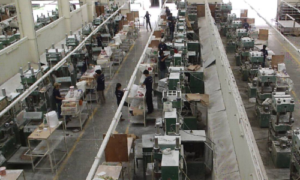 For Hue La, managing director of Van Dat, the time and cost that go into digital transformation are ultimately all about people. In her medium-sized business, Hue La implemented a digitalization strategy by using a people-centered approach. She encountered all the challenges well known to entrepreneurs on their journey towards digitalization. Van Dat, Hue La’s enterprise, is a top manufacturing and warehousing company in Vietnam that specializes in producing kitchenware utensils for export and the business-to-business (B2B) market, as well as providing warehousing services for small and medium-sized enterprises (SMEs), startups, and multinational companies in Vietnam. Founded in 1989, the company was 26 years old when Hue La became its new managing director in 2015. Since Van Dat is a manufacturing company, technology—be it in the form of machinery for sustainable production or digital solutions for operations—has always been an integral part of the enterprise. Hue La invested much effort into keeping Van Dat updated and compatible with the times: “Change is the only constant, and now more than ever before. We cannot stick to the old traditional way of doing things. We need a catalyst to help us reach more customers, to help us save time and cost.”
For Hue La, managing director of Van Dat, the time and cost that go into digital transformation are ultimately all about people. In her medium-sized business, Hue La implemented a digitalization strategy by using a people-centered approach. She encountered all the challenges well known to entrepreneurs on their journey towards digitalization. Van Dat, Hue La’s enterprise, is a top manufacturing and warehousing company in Vietnam that specializes in producing kitchenware utensils for export and the business-to-business (B2B) market, as well as providing warehousing services for small and medium-sized enterprises (SMEs), startups, and multinational companies in Vietnam. Founded in 1989, the company was 26 years old when Hue La became its new managing director in 2015. Since Van Dat is a manufacturing company, technology—be it in the form of machinery for sustainable production or digital solutions for operations—has always been an integral part of the enterprise. Hue La invested much effort into keeping Van Dat updated and compatible with the times: “Change is the only constant, and now more than ever before. We cannot stick to the old traditional way of doing things. We need a catalyst to help us reach more customers, to help us save time and cost.”
People First
Being the youngest in a company—and simultaneously its leader—is not an easy feat. The process of digital transformation, which Hue La occupied herself with six years ago when she joined Van Dat, proved to be a long and painful process that required having clear goals and much determination. Hue La started by putting together a special task force team that included managers, department heads, and the IT team. Together, they discussed their vision of the company within the next three years. Despite some initial resistance, most of her team members were on board during the change. Sometimes it was even Van Dat’s eager and encouraging employees who initiated adopting digital solutions. In Hue La’s classification, her team members generally fall into three types: tech-savvy early adopters, those resistant to change, and those who are indecisive. The main concerns behind resistance are salary reductions and job loss: “Change can be scary and risky and would require a lot of effort.” Seeking to persuade her less enthusiastic staff, Hue La leveraged the zeal of the early adopters from the sales and marketing, and IT departments.
Hue La always communicated the company’s goals clearly and articulated her vision of the benefits of digitalization: “It’s very important to find common ground and identify the basic goals that everyone can agree on.” Along with verbal encouragement, Hue La used other incentives and rewards, such as bonuses. Today, while seeking to recruit candidates with an innovative mindset and advanced digital skills, Hue La prioritizes good working environments that would instill a growth mindset among her employees. Equally important for Hue La is the sense of community, which helps her team to not only better connect with each other, but also to better understand their needs. Ultimately, the sense of community among Hue La’s staff allows them to efficiently upskill their digital knowledge.

A how-to guide for successful digital transformation
Initially, Van Dat heavily relied on Excel and manual input in tracking inventory, computing salaries, or calculating raw material costs, which generated errors. To address this concern, Hue La’s task force team jointly decided to invest in an enterprise resource planning system (ERP), and this decision proved to be immensely beneficial. However, there were several challenges, too. For instance, although the implementation of the ERP system in 2015 coincided with the period of Van Dat’s rapid growth, the company was unable to keep up with the demand. To better serve their clients through up-to-date and real-time data, Van Dat’s team needed well-informed decisions made within less time.
The ERP implementation stage also required the painstaking and multi-phase process of digitizing all existing paperwork into the new system, which took years until full completion. Notwithstanding, the team followed a predetermined roadmap and timeline for each department while preserving their daily operations and rolling out training activities for the new digital system. Their joint success was enabled by a close collaboration between the IT team and the supplier.
Despite slowing Van Dat’s operations, the COVID-19 pandemic incentivized the Van Dat team to ramp up training programs for various digital technologies, and Hue La is grateful for the downtime it offered her and the team to recollect themselves.
In retrospect, Van Dat’s story of digital transformation is a model success story. With her innovative approaches and diplomatic leadership skills, Hue La set an example for the ideal employer-employee relationship.
Hue La’s focus on community and sustainable development is explicit in her decision to adopt an ERP system from a local supplier. Fully aligned with Vietnamese regulations, this adoption facilitated Van Dat’s services and made them more flexible.
